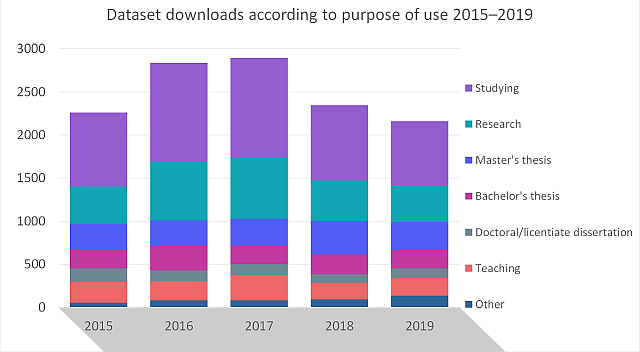Qualitative data growing in popularity
FSD archived and processed more qualitative datasets in 2019 than in 2018. Users also downloaded qualitative datasets from Aila Data Service more frequently than before, and the use of freely available datasets increased. On the whole, the number of registered users and the reuse of data decreased slightly.
Datasets were widely used in Finnish higher education institutions. The most data were downloaded at Tampere University (18%) and the Universities of Helsinki (14%), Turku (13%) and Jyväskylä (13%). 7 percent of the dataset downloads came from registered users abroad (2018: 7%), and one in six datasets were downloaded from the English data catalogue of Aila. Many of the quantitative datasets archived at FSD are already available in English and more are translated on request.
Last year, data downloads from Aila saw an 8 percent decrease from 2018. In total, FSD processed 1,882 access applications in 2019 (2018: 1 954). 2,159 datasets were delivered for reuse (2018: 2 344), of which 80% were quantitative (2018: 83%) and 20% qualitative (2018: 17%). A single user can download the same dataset multiple times while the access application is in effect, which is why the number of datasets distributed for reuse is higher than the number of processed access applications. All in all, between 2014 and 2019, approximately 13,700 datasets have been downloaded from Aila.
Users downloaded datasets most actively in January, September and October. Most of the datasets were used for seminar papers and other study purposes (34%). Additionally, datasets were distributed for theses, such as Bachelor’s, Master’s and Doctoral theses (in total 30%), other research (20%), and teaching (9%). Utilising an existing dataset appeals to both registered users and the users of openly accessible data.

The most popular dataset in 2019 was FSD2922 European Social Survey 2012: Finnish Data, which studied personal and social well-being and opinions on democracy. Of the datasets published in 2019, the most downloaded datasets were FSD3355 Public Procurement Notices 2018, FSD3242 Vocational School Student Survey 2017 and FSD3321 Working and Poor 2015.
In 2019, 768 unique registered users downloaded data from Aila (2018: 830). Openly accessible data were downloaded by 440 persons (2018: 399). Overall, there were 2,623 registered Aila users at the end of 2019 (2018: 2,925).
FSD’s data repository gained 79 new datasets in 2019 (2018: 89). 77 new datasets were published on Aila (2018: 79): 52 quantitative datasets (2018: 62) and 25 qualitative datasets (2018: 17). At the end of 2019, Aila contained a total of 1,494 datasets, of which 1,266 were quantitative and 228 qualitative. Three openly accessible datasets were published on Aila Data Service in 2019. By the end of the year, a total of 85 openly accessible datasets were available for download.
The overall use of the FSD website grew notably in 2019; the number of site requests increased by 10 percent compared to 2018. The Research Methods Web Resource (MOTV) grew the most in popularity, and especially its qualitative research methods section. Due to the parliamentary elections that were held in April 2019, the number of visitors on Pohtiva, FSD’s party agenda database, also increased. You can learn more about data use rates and other FSD operations in the annual report published online later this spring (in Finnish).